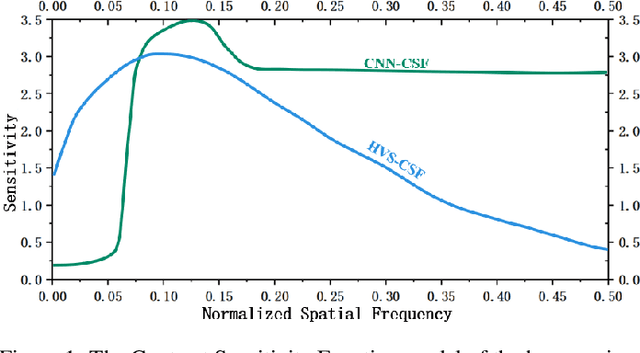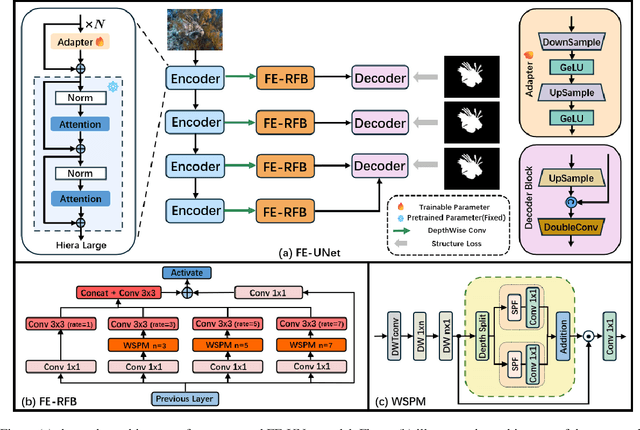Ling Shao
Terminus Group, Beijing, China
Spatial Preference Rewarding for MLLMs Spatial Understanding
Oct 16, 2025Abstract:Multimodal large language models~(MLLMs) have demonstrated promising spatial understanding capabilities, such as referencing and grounding object descriptions. Despite their successes, MLLMs still fall short in fine-grained spatial perception abilities, such as generating detailed region descriptions or accurately localizing objects. Additionally, they often fail to respond to the user's requirements for desired fine-grained spatial understanding. This issue might arise because existing approaches primarily focus on tuning MLLMs to model pre-annotated instruction data to inject spatial knowledge, without direct supervision of MLLMs' actual responses. We address this issue by SPR, a Spatial Preference Rewarding~(SPR) approach that enhances MLLMs' spatial capabilities by rewarding MLLMs' detailed responses with precise object localization over vague or inaccurate responses. With randomly selected image regions and region descriptions from MLLMs, SPR introduces semantic and localization scores to comprehensively evaluate the text quality and localization quality in MLLM-generated descriptions. We also refine the MLLM descriptions with better localization accuracy and pair the best-scored refinement with the initial descriptions of the lowest score for direct preference optimization, thereby enhancing fine-grained alignment with visual input. Extensive experiments over standard referring and grounding benchmarks show that SPR improves MLLM spatial understanding capabilities effectively with minimal overhead in training. Data and code will be released at https://github.com/hanqiu-hq/SPR
Aesthetic Image Captioning with Saliency Enhanced MLLMs
Sep 04, 2025Abstract:Aesthetic Image Captioning (AIC) aims to generate textual descriptions of image aesthetics, becoming a key research direction in the field of computational aesthetics. In recent years, pretrained Multimodal Large Language Models (MLLMs) have advanced rapidly, leading to a significant increase in image aesthetics research that integrates both visual and textual modalities. However, most existing studies on image aesthetics primarily focus on predicting aesthetic ratings and have shown limited application in AIC. Existing AIC works leveraging MLLMs predominantly rely on fine-tuning methods without specifically adapting MLLMs to focus on target aesthetic content. To address this limitation, we propose the Aesthetic Saliency Enhanced Multimodal Large Language Model (ASE-MLLM), an end-to-end framework that explicitly incorporates aesthetic saliency into MLLMs. Within this framework, we introduce the Image Aesthetic Saliency Module (IASM), which efficiently and effectively extracts aesthetic saliency features from images. Additionally, we design IAS-ViT as the image encoder for MLLMs, this module fuses aesthetic saliency features with original image features via a cross-attention mechanism. To the best of our knowledge, ASE-MLLM is the first framework to integrate image aesthetic saliency into MLLMs specifically for AIC tasks. Extensive experiments demonstrated that our approach significantly outperformed traditional methods and generic MLLMs on current mainstream AIC benchmarks, achieving state-of-the-art (SOTA) performance.
Spatial-Temporal Graph Mamba for Music-Guided Dance Video Synthesis
Jul 09, 2025



Abstract:We propose a novel spatial-temporal graph Mamba (STG-Mamba) for the music-guided dance video synthesis task, i.e., to translate the input music to a dance video. STG-Mamba consists of two translation mappings: music-to-skeleton translation and skeleton-to-video translation. In the music-to-skeleton translation, we introduce a novel spatial-temporal graph Mamba (STGM) block to effectively construct skeleton sequences from the input music, capturing dependencies between joints in both the spatial and temporal dimensions. For the skeleton-to-video translation, we propose a novel self-supervised regularization network to translate the generated skeletons, along with a conditional image, into a dance video. Lastly, we collect a new skeleton-to-video translation dataset from the Internet, containing 54,944 video clips. Extensive experiments demonstrate that STG-Mamba achieves significantly better results than existing methods.
Replace in Translation: Boost Concept Alignment in Counterfactual Text-to-Image
May 20, 2025Abstract:Text-to-Image (T2I) has been prevalent in recent years, with most common condition tasks having been optimized nicely. Besides, counterfactual Text-to-Image is obstructing us from a more versatile AIGC experience. For those scenes that are impossible to happen in real world and anti-physics, we should spare no efforts in increasing the factual feel, which means synthesizing images that people think very likely to be happening, and concept alignment, which means all the required objects should be in the same frame. In this paper, we focus on concept alignment. As controllable T2I models have achieved satisfactory performance for real applications, we utilize this technology to replace the objects in a synthesized image in latent space step-by-step to change the image from a common scene to a counterfactual scene to meet the prompt. We propose a strategy to instruct this replacing process, which is called as Explicit Logical Narrative Prompt (ELNP), by using the newly SoTA language model DeepSeek to generate the instructions. Furthermore, to evaluate models' performance in counterfactual T2I, we design a metric to calculate how many required concepts in the prompt can be covered averagely in the synthesized images. The extensive experiments and qualitative comparisons demonstrate that our strategy can boost the concept alignment in counterfactual T2I.
Exploring 3D Activity Reasoning and Planning: From Implicit Human Intentions to Route-Aware Planning
Mar 17, 2025Abstract:3D activity reasoning and planning has attracted increasing attention in human-robot interaction and embodied AI thanks to the recent advance in multimodal learning. However, most existing works share two constraints: 1) heavy reliance on explicit instructions with little reasoning on implicit user intention; 2) negligence of inter-step route planning on robot moves. To bridge the gaps, we propose 3D activity reasoning and planning, a novel 3D task that reasons the intended activities from implicit instructions and decomposes them into steps with inter-step routes and planning under the guidance of fine-grained 3D object shapes and locations from scene segmentation. We tackle the new 3D task from two perspectives. First, we construct ReasonPlan3D, a large-scale benchmark that covers diverse 3D scenes with rich implicit instructions and detailed annotations for multi-step task planning, inter-step route planning, and fine-grained segmentation. Second, we design a novel framework that introduces progressive plan generation with contextual consistency across multiple steps, as well as a scene graph that is updated dynamically for capturing critical objects and their spatial relations. Extensive experiments demonstrate the effectiveness of our benchmark and framework in reasoning activities from implicit human instructions, producing accurate stepwise task plans, and seamlessly integrating route planning for multi-step moves. The dataset and code will be released.
MambaIC: State Space Models for High-Performance Learned Image Compression
Mar 16, 2025Abstract:A high-performance image compression algorithm is crucial for real-time information transmission across numerous fields. Despite rapid progress in image compression, computational inefficiency and poor redundancy modeling still pose significant bottlenecks, limiting practical applications. Inspired by the effectiveness of state space models (SSMs) in capturing long-range dependencies, we leverage SSMs to address computational inefficiency in existing methods and improve image compression from multiple perspectives. In this paper, we integrate the advantages of SSMs for better efficiency-performance trade-off and propose an enhanced image compression approach through refined context modeling, which we term MambaIC. Specifically, we explore context modeling to adaptively refine the representation of hidden states. Additionally, we introduce window-based local attention into channel-spatial entropy modeling to reduce potential spatial redundancy during compression, thereby increasing efficiency. Comprehensive qualitative and quantitative results validate the effectiveness and efficiency of our approach, particularly for high-resolution image compression. Code is released at https://github.com/AuroraZengfh/MambaIC.
SOGS: Second-Order Anchor for Advanced 3D Gaussian Splatting
Mar 10, 2025Abstract:Anchor-based 3D Gaussian splatting (3D-GS) exploits anchor features in 3D Gaussian prediction, which has achieved impressive 3D rendering quality with reduced Gaussian redundancy. On the other hand, it often encounters the dilemma among anchor features, model size, and rendering quality - large anchor features lead to large 3D models and high-quality rendering whereas reducing anchor features degrades Gaussian attribute prediction which leads to clear artifacts in the rendered textures and geometries. We design SOGS, an anchor-based 3D-GS technique that introduces second-order anchors to achieve superior rendering quality and reduced anchor features and model size simultaneously. Specifically, SOGS incorporates covariance-based second-order statistics and correlation across feature dimensions to augment features within each anchor, compensating for the reduced feature size and improving rendering quality effectively. In addition, it introduces a selective gradient loss to enhance the optimization of scene textures and scene geometries, leading to high-quality rendering with small anchor features. Extensive experiments over multiple widely adopted benchmarks show that SOGS achieves superior rendering quality in novel view synthesis with clearly reduced model size.
FE-UNet: Frequency Domain Enhanced U-Net with Segment Anything Capability for Versatile Image Segmentation
Feb 06, 2025



Abstract:Image segmentation is a critical task in visual understanding. Convolutional Neural Networks (CNNs) are predisposed to capture high-frequency features in images, while Transformers exhibit a contrasting focus on low-frequency features. In this paper, we experimentally quantify the contrast sensitivity function of CNNs and compare it with that of the human visual system, informed by the seminal experiments of Mannos and Sakrison. Leveraging these insights, we propose the Wavelet-Guided Spectral Pooling Module (WSPM) to enhance and balance image features across the frequency domain. To further emulate the human visual system, we introduce the Frequency Domain Enhanced Receptive Field Block (FE-RFB), which integrates WSPM to extract enriched features from the frequency domain. Building on these innovations, we develop FE-UNet, a model that utilizes SAM2 as its backbone and incorporates Hiera-Large as a pre-trained block, designed to enhance generalization capabilities while ensuring high segmentation accuracy. Experimental results demonstrate that FE-UNet achieves state-of-the-art performance in diverse tasks, including marine animal and polyp segmentation, underscoring its versatility and effectiveness.
Laser: Efficient Language-Guided Segmentation in Neural Radiance Fields
Jan 31, 2025



Abstract:In this work, we propose a method that leverages CLIP feature distillation, achieving efficient 3D segmentation through language guidance. Unlike previous methods that rely on multi-scale CLIP features and are limited by processing speed and storage requirements, our approach aims to streamline the workflow by directly and effectively distilling dense CLIP features, thereby achieving precise segmentation of 3D scenes using text. To achieve this, we introduce an adapter module and mitigate the noise issue in the dense CLIP feature distillation process through a self-cross-training strategy. Moreover, to enhance the accuracy of segmentation edges, this work presents a low-rank transient query attention mechanism. To ensure the consistency of segmentation for similar colors under different viewpoints, we convert the segmentation task into a classification task through label volume, which significantly improves the consistency of segmentation in color-similar areas. We also propose a simplified text augmentation strategy to alleviate the issue of ambiguity in the correspondence between CLIP features and text. Extensive experimental results show that our method surpasses current state-of-the-art technologies in both training speed and performance. Our code is available on: https://github.com/xingy038/Laser.git.
Enhanced Multi-Scale Cross-Attention for Person Image Generation
Jan 15, 2025



Abstract:In this paper, we propose a novel cross-attention-based generative adversarial network (GAN) for the challenging person image generation task. Cross-attention is a novel and intuitive multi-modal fusion method in which an attention/correlation matrix is calculated between two feature maps of different modalities. Specifically, we propose the novel XingGAN (or CrossingGAN), which consists of two generation branches that capture the person's appearance and shape, respectively. Moreover, we propose two novel cross-attention blocks to effectively transfer and update the person's shape and appearance embeddings for mutual improvement. This has not been considered by any other existing GAN-based image generation work. To further learn the long-range correlations between different person poses at different scales and sub-regions, we propose two novel multi-scale cross-attention blocks. To tackle the issue of independent correlation computations within the cross-attention mechanism leading to noisy and ambiguous attention weights, which hinder performance improvements, we propose a module called enhanced attention (EA). Lastly, we introduce a novel densely connected co-attention module to fuse appearance and shape features at different stages effectively. Extensive experiments on two public datasets demonstrate that the proposed method outperforms current GAN-based methods and performs on par with diffusion-based methods. However, our method is significantly faster than diffusion-based methods in both training and inference.
 Add to Chrome
Add to Chrome Add to Firefox
Add to Firefox Add to Edge
Add to Edge